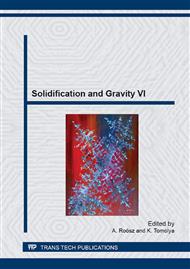p.46
p.52
p.59
p.67
p.73
p.79
p.85
p.91
p.97
Understanding Channel Segregates in Numerical Models of Alloy Solidification: A Case of Converge First and Ask Questions Later
Abstract:
In static castings of multi-component alloys, visually observable bands of channels, with high solute concentration, can form in the final solidified product. The phenomenological explanation for these formations is that perturbations during the solidification process lead to preferred flow paths in the solid-liquid mushy region. Once these flow paths are initiated, the higher solute liquid that flows in them suppresses the solidification rate and thus provides a mechanism through which the preferred paths can evolve into high concentration channels. Models of solidification that couple heat transfer, fluid and flow and mass transport appear able to predict the formation of these channels. In many cases, however, the formation of these numerical channels is highly dependent on the nature of the numerical calculation. In particular, geometric attributes of the channels is a strong function of the size of the computational grid and in some cases the particular method (code) used. In this work, after discussing what might drive the observed discrepancies in predictions, a grid convergence study is undertaken. This study shows that for the case of a side cooled solidification of a binary (Al-4.5wt%Cu) in a square (40mm x 40mm) domain, it is possible to approach grid converged results of the solution of the standard mixture model for macrosegregation. Achieving this level of convergence requires the use of an explicit time stepping scheme to couple the thermal and solute fields along with a Carman-Kozeny permeability and lever rule microsegregation models. The results indicate that to reach grid convergence the size of a grid cell has to be on the order ~0.25-0.5 mm.
Info:
Periodical:
Pages:
73-78
Citation:
Online since:
May 2014
Authors:
Price:
Сopyright:
© 2014 Trans Tech Publications Ltd. All Rights Reserved
Share:
Citation:


